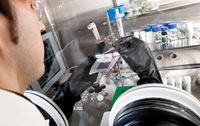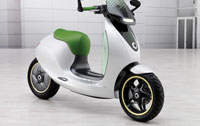Next year, German chemical company Evonik Industries will test an unusual prototype battery, part of its LESSY (lithium electricity storage system) project. The prototype, located at a power plant in Germany, will be put through its paces in supplying primary regulation energy. ‘The LESSY-system is a demonstration to check to what extent primary control – which requires 100% power for up to 15 minutes – can be taken over by a battery system,’ explains Dick Uwe Sauer of Aachen University in Germany. ‘This is especially important if large quantities of wind or photovoltaic cells are in the grid, because the number of conventional power plants is reduced at these points of time and wind and photovoltaic power can not supply primary control.’
The device is about the size of a standard oceangoing freight container and holds 4700 battery cells. It will have an output of approximately 1MW and storage capacity of about 700kW hours. According to Evonik, if the device was charged and discharged every 15 minutes, it would meet the energy demands of 4000 households/year. The advantage of the Li-ion battery is its ability to expand or reduce its storage capacity very quickly. The power storage system contains the same lithium-ion cells that the company developed for use in electric cars, with a ceramic separator developed by Evonik.
According to Martin Winter of Munster University, LESSY is based on fairly standard lithiumion battery chemistry. The negative electrode (anode) is graphite, while the positive electrode (cathode) is based on a lithium nickel-cobalt-manganese oxide. The electrolyte, through which the lithium ions travel during discharge from the anode to the cathode, is a typical organic solvent-based solution, explained Winter. ‘It’s a regular advanced battery from Li-tec, which they designed in a way that is more appropriate for stationary applications.’ Li-Tec is a partnership between Evonik and the car maker Daimler.
The tweaking potential in lithium-ion batteries is a major bonus. Because there are lots of variety in the compounds, with millions of possible material combinations, one can design a system for particular applications, says Winter. For anodes, it will be difficult to do better than carbon, but there are many choices when it comes to the cathode and electrolyte and separators. But there are downsides. Lithium-ion batteries are a challenging technology and chemists must grapple with more safety issues than for other battery options. ‘Each cell needs supervision and balancing,’ says Saur. ‘Careful temperature management is necessary. The integration of lithium-ion battery cells into battery systems is significantly more complex and expensive, compared with say lead-acid or nickelmetal- hydride batteries.’
Due to the high reactivity of lithium metal and related safety concerns, you must dilute this reactivity, explains Winter. But if one looks at the packaging required at the moment, it’s a joke, he says. ‘So-called lithium-ion batteries contain maybe 5% of lithium ions and only these ions go with electrons and current. The lithium ions are in storage materials, which serve as hosts for the lithium ion guests. That means you are buying a lot of packaging when you buy a “high energy” lithium-ion cell. So there is a lot of R&D activity today trying to get rid of this packaging,’ he says. Packaging adds cost and weight too.

Lithium iron phosphate is a cathode option that is safe, cheap, and capable of fast charge and discharge, notes John Goodenough at the University of Texas, US, who helped pioneer the very first lithium-ion cathode in the early 1990s in the UK. ‘However, it does not give as high a voltage as possible in the electrolyte.’ Oxides containing manganese and nickel are the best alternatives at the moment and are looked on as promising for cars, which is the market most companies now want to tap into.
Electric vehicle market
The world’s leading chemical company BASF’s interest in battery technology was reignited around 2008. ‘Our focus is battery materials for electric car batteries; we do not look at consumer applications for example,’ said Ruediger Oesten, battery expert from BASF Future Business. ‘If you look at the consumer market, it is dominated 100% by Asian players and for the rest of the world there is little chance of getting in, so we have to focus on the new market and that new market is electromobility.’ Having missed the boat first time around, companies are eager to join the fray in time for the next generation of batteries.
And there’s plenty of scope for improvement, according to Robert Outram, an analyst with Frost & Sullivan. ‘Current battery technology for transport isn’t good enough for what the industry needs and the industry is well aware of this, so there is a lot of modification of lithium-ion batteries.’ He is confident lithium-ion batteries exclusively will power future electric vehicles (EVs), muscling out the nickel-metal-hydride batteries in today’s hybrid cars, because of the power required and the amount of storage needed. But the stability of these batteries gives cause for concern, says Outram.
‘At the moment, the electrolyte in the battery is only really good for three to five years,’ he says. ‘After numerous discharges, the electrolyte won’t hold the charge it held when it was new.’ Yet the competition, the internal combustion engine, is good for up to two decades. Outram says safety is a factor too. In the early days, heat build-up and even fire was a risk with lithium-ion batteries in consumer devices. But now you’ve got 800 or so lithium-ion cells side-by-side, so the amount of heat generated is enormous and the potential for fires is a real concern, notes Outram.
Higher energy means more lithium ions and more reactivity, and cars need a high energy propulsion source. ‘We are putting together highly reactive materials at a very short distance from each other, just separated by a separator of 25 microns, so this could be a problem,’ says Winter. And the organic electrolyte, which is in a gel form, is flammable. ‘If one charges too rapidly, lithium is plated out on the carbon anode,’ explains Goodenough. ‘Once that happens, lithium dendrites form and grow on repeated charges until they short the battery to produce thermal runaway and fire.’ Engineering improvements are feasible: engineering the battery-pack design to permit failure of one cell without compromising the entire stack improves safety, for example.
Electrolyte development
Improving the electrolyte is a challenge. Goodenough says it can be improved by blending the organic electrolyte with an ionic liquid. This will eliminate flammability, but at the expense of the rate of charge-discharge. The point highlights a common theme in modifying lithium-ion batteries: you make gains, but at a cost. ‘Nobody knows which compromises will win out in future,’ says Oesten. ‘Depending what you are looking for, energy density or safety, then you have to choose your materials, and there is no ideal solution.’ BASF is prioritising research on cathode materials. The second priority is electrolytes, though they will look at many other aspects of the battery too.
Today’s Li-ion batteries generally deliver up to 4.2 or 4.3V. It is possible to increase voltage to increase power (power = discharge current X voltage). New higher voltage materials with 4.9 and even 5.1V do exist, says Oesten, but they are R&D materials. What is more, there’s a fly in the ointment. For such materials, new electrolytes are needed.

Dow Kokam is a joint venture set up in 2009 to develop and manufacture batteries for transport uses; it received $161m from the Department of Energy for a manufacturing plant in Michigan under the recovery act. O’Driscoll says the plant will use Kokam technology which offers advantages in terms of how the cathode–anode pairs are stacked. The new plant is projected to have the capacity to manufacture 1.2bn watt hours of large-format Li-ion batteries, enough to power 60,000 fully electric vehicles annually.
Stationary in the US
More work is needed for stationary applications though. ‘We have not yet developed the most optimal technologies for large-scale stationary applications,’ says Gary L. Henriksen of the Argonne National Laboratory in the US. Some forms of Li-ion batteries may meet the needs in some applications, but getting the cost down will be a real challenge, he adds. A yet-to-be developed flow battery system may offer the most promise, because you can decouple the power from the energy. Flow batteries rely on an electrolyte that flows through a cell.
The US government has remained aloof from funding Li-ion batteries for grids, with zero government funding for advanced battery R&D related to stationary applications, which somewhat puzzles Henriksen. ‘We agree that it is important to develop more optimal storage systems to help expand the use of renewable energy sources,’ he notes. ‘I don’t really know why the US has not been funding advanced battery R&D for stationary applications at a higher level to date. We have attempted to help the decision makers appreciate the need for significant R&D program in this area, but have been relatively unsuccessful to date.’
However, there is considerable interest elsewhere. Sauer of Aachen University will chair some of the sessions at the 5th International Renewable Energy Storage Conference to be held in Berlin during November 2010. The audience will hear about the importance of energy storage in a renewable energy supply system, including speakers from Saft Industrial Battery Group in France, the Mitsubishi Research Institute in Japan, GE Global Research in Germany, ZBB Energy in Australia, Samsung SDI in South Korea and Siemens in Germany.
The focus on lithium-ion batteries does not exclude the possibility of newer batteries emerging. BASF announced in summer 2010 that it had set up an international competence network to focus on new materials and functional components for future battery types, such as lithium sulphur and lithium air batteries. These could be the next generation materials, says Oesten, but for now they are R&D projects, far from commercialisation. Zinc air, for example, is an open battery with a water-based electrolyte that easily dries out. Henriksen says Li/air and Li/S batteries offer advantages in terms of higher energy density, but both are high risk technologies that face many technological challenges. ‘We have R&D projects addressing these challenges, but major breakthroughs will be necessary to make them commercially viable.’
No shortage of lithium metal supply
Lithium, an unusual metal, is not actually rare. According to metals analyst Jack Lifton, lithium is abundant in accessible deposits and the price is as likely to decline as rise. ‘Lithium has been little produced because there has been little demand,’ he says. ‘Supply is not a problem.’ Outram, though, sees a potential downside to the widespread adoption of lithium-ion batteries. If 10% of the UK car fleet became EVs, that equates to 6m vehicles. ‘How do you dispose of potentially millions of batteries,’ he asks. If the battery degrades to say 40% of its performance, it probably won’t be good enough to use in a vehicle: ‘But it might be good enough to be used for electrical storage.’
Indeed, Nissan and Sumitomo announced in September 2010 that they are to carry out research on second-life use of lithium-ion batteries that have previously served in electric cars. That’s the same Li-ion battery in an EV born again for home uses. It seems, Li-ion power may one day be ubiquitous in our electric grids, cars, homes and gadgets.
Anthony King is a freelance science writer based in Dublin, Ireland.





